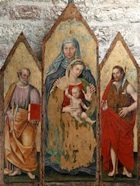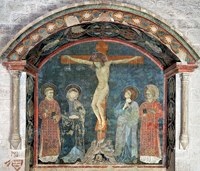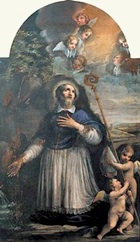

The Museo Diocesano is housed in Palazzo dei Canonici. The stairs [where ??] lead to what is now Room IV. Rooms I-III are straight ahead while Room V (the old refectory) is behind you.
The rest of the permanent collection is in a series of rooms on the lower floor. The first of these was the kitchen, and it retains the original brick oven to the left of the entrance. This room contains a number of interesting architectural exhibits, including Roman inscriptions found in the area, and architectural fragments from the old Duomo.
Where ??
Cope (15th century)
According to tradition, Pope Marcellus II, who had been Bishop of Gubbio, gave Flemish brocade cope to the Duomo in 1555, the year of his papacy and of his death. However, it was probably made locally at an earlier date, using designs by a follower of Joos van Wassenhove (Justus of Ghent), a Flemish artist who was active at the court of Duke Federico da Montefeltro in the 1470s.
The cope was originally decorated with seven embroidered panels depicting scenes from the Passion of Christ:
-
✴Christ before Pilate*;
-
✴Christ in the Garden of Gethsemane*;
-
✴the kiss of Judas*;
-
✴the Flagellation,
-
✴the crown of thorns;
-
✴the road to Calvary; and
-
✴the Communion of the Apostles (on the hood).
Unfortunately, the three panels marked with an asterisk above were stolen in 1993.
Room I (off the Cloister)
Scenes from the Passion (15th century)
These detached frescoes, which were detached from the crypt of the church of Santa Maria dei Laici in the 1970s, are attributed to Giacomo di Benedetto Bedi. They depict:
-
✴Christ washing the feet of the Disciples;
-
✴the Last Supper;
-
✴Christ praying in the Garden of Gethsemane;
-
✴the Crucifixion;
-
✴the Deposition;
-
✴the scene at the abandoned tomb.
[The frescoes are temporarily displayed here, but will be returned to their original location.]
Room II
SS Marianus and James (late 13th century)
These originally polychrome marble statues of the saints dressed as deacons probably came from the Duomo.
Madonna and Child with angels (13th century)
This large detached fresco, which is attributed to the Maestro Espressionista di Santa Chiara (Palmerino di Guido?), was detached from the facade of Santa Maria dei Laici in 1974.
Madonna in Glory with Angels (14th century)
This altarpiece, which came from the Pieve d’ Agnano outside Umbertide, is signed “Opus Melli de Eugubio” (the work of Mello da Gubbio). The work was attributed to Guido Palmeruccio until its restoration in 1979, when the signature was discovered.
The Crucifixion (ca. 1500) on the back is by an unknown artist.
Madonna and Child (14th century)
This altarpiece, which came from the Pieve di Valdichiascio, is attributed to Mello da Gubbio.
St Antony Abbot (14th century)
This fresco, which was detached from an external niche on the right wall of Santa Maria dei Laici in 1964, is attributed to Guiduccio Palmerucci.
Room III
St Clare (early 15th century)
This fragment, which is the upper part of a panel that probably came from a polyptych, was the subject of a bequest to the museum. It depicts the upper part of St Clare holding the pyx with which she repelled a Ghibelline attack on San Damiano, Assisi. It is attributed to Taddeo di Bartolo di Mino.
Room IV
Assumption of the Virgin (16th century)
This panel , which was moved to the museum from the the Pieve di Valdichiascio in 1932, was traditionally attributed to Timoteo Viti. It has recently been restored and attributed alternatively to Giuliano Presutti.
Triptych (16th century)

St Vincent Ferrer (16th century)
This altarpiece from San Domenico is by/attributed to Felice Damiani.
Detached frescoes (16th century)
These frescoes, which came from the Pieve di Caprignone, depict:
-
✴the Madonna and Child with SS Francis and Antony of Padua; and
-
✴the Madonna and Child with SS Roch and Sebastian.
St Peter Martyr (17th century)
This altarpiece from San Domenico is attributed to Rutilio Manetti.
Room V
This room was originally the refectory of Palazzo dei Canonici.
Crucifixion with the Virgin and Saints (ca. 1300)

This fresco, which remains in situ in a niche in the wall of this room, is attributed to the Maestro della Croce di Gubbio. It depicts of the Crucifixion with the Virgin and St John the Evangelist, flanked by two of the patron saints of Gubbio: SS James and Marianus.
Immaculate Conception (ca. 1666)
This altarpiece, which is attributed to Francesco Allegrini, is of unknown provenance. [San Marziale ??]
Blessed Villanus (17th century)
St Sebastian (1673 ?)
This panel, which is by/attributed to Francesco Allegrini, is of unknown provenance.
Madonna and Child (17th century)
This panel, which the subject of a bequest to the museum, is attributed to Giovanni Battista Salvi (Sassoferrato).


